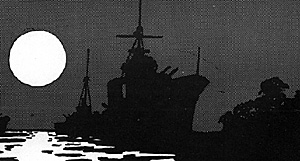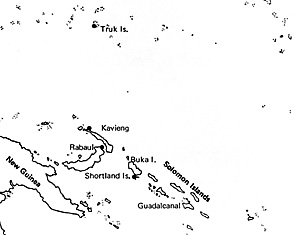Tactical and Strategic Doctrine and Training
 The Japanese plan for the war in the Pacific called for the assumption of the strategic defensive once certain vital areas were captured. The Allies were to be bogged down in a war of attrition against strong defences. Guadalcanal was at no time within the defensive perimeter established for this purpose. Japan actually discarded its plan to go to the defensive, and played the role it had intended for the U.S.
The Japanese plan for the war in the Pacific called for the assumption of the strategic defensive once certain vital areas were captured. The Allies were to be bogged down in a war of attrition against strong defences. Guadalcanal was at no time within the defensive perimeter established for this purpose. Japan actually discarded its plan to go to the defensive, and played the role it had intended for the U.S.
It is doubtful that the Allies' position in the Pacific would have been improved if Japan had given up Guadalcanal without a struggle. In effect, the U.S. invasion of Guadalcanal amounted to a dare -- the Marines entrenched themselves on the island and waited for the Japanese to attempt to evict them from it. Neither U.S. nor Japanese planners realized until after the battle that the value of the island of Guadalcanal lay not in its size or location but in the fact that both sides were willing to commit large forces to gain undisputed control of it.
In formulating their plans, the opposing sides differed in content and procedure. The Japanese tended to formulate detailed plans, and stick closely to them. Their plans often called for close cooperation between large numbers of small groups of ships, relying upon coordination of movement. This lead to tactical inflexibllity, which of course did not show up if the plan was good.
Similarly, if the size of the force was managable, the Japanese commanders tended to do remarkable well.
Tactical training stressed small unit maneuvres and night combat, particularly so for the destroyers. This emphasis, along with the superiority of Japanese torpedo weapons systems, qave the Japanese a most potent, albeit specialized, force. Less than optimum results were obtained from forces which had not operated previously together, and in many cases the squadrons and divisions at Guadalcanal were reconstituted units with new ships taking the place of losses and transfers.
Fleet Operations and Organization
As the Order of Battle shows, the Eighth Fleet had 5 heavy and 3 light cruisers, 7 destroyers, 7 troop transports, 3 seaplane tenders, and 1 flying boat tender at the time of the U.S. invasion of Guadalcanal. Also under Eighth Fleet were 4 Naval Base Forces, 5 Special Naval Landing Forces, and about 20 torpedo bombers and 20 fighters. Also at Rabaul were 30 medium bombers and 20 fighters of the Eleventh Air Fleet and the 144th Infantry Regiment of the 17th Army.
This small force moved against the U.S. forces as soon as the invasion was discovered. A Naval Landing Force [the 5th Sasebo] was sent to Guadalcanal, the aircraft in the area began attacks against the Allied forces, and a cruiser force under Admiral Mikawa set out to destroy Allied shipping. The SNLF, meanwhile, was turned back by a U.S. submarine, and the 144th Infantry was sent to Papua.
The Japanese cruiser force handed a crushing defeat to the Allied covering force, sinking four and damaging one of the six cruisers in the area. They did not, however, attempt to attack the U.S. transports.
Because the U.S. controlled the airfield at Guadalcanal, the Japanese were at a distinct disadvantage in daylight naval operations. Their transports, being slow, were easy targets for U.S. aircraft. In order to overcome this problem, the Japanese began using destroyers to transport troops and supplies to the island.
Their missions were timed so that the ships would come into range of U.S. aircraft just at dusk, unload their cargo and perhaps shell the Marines' positions under cover of darkness, and leave aircraft range at dawn.
As soon as news of the invasion reached Japan, the major portion of the Combined Fleet made preparations to move to the area, with Truk atoll designated as its base. Once this move had been successfully made, the Japanese began to plan for a decisive battle against the U.S. carriers. Twice the Combined Fleet sortied from Truk with the aim of isolating the U.S. garrison on Guadalcanal, and both times they failed to do so.
Other sorties were carried out by Combined Fleet with intent to bombard the Guadalcanal airfield. Both cruisers and battleships participated in these bombardments. Although they were, on occasion, quite effective, they could not be sustained.
The Third Fleet was originally intended to be the carrier force, and the Second Fleet was to be the battle force, but, as the campaign wore on, these distinctions were forgotten. The Eighth Fleet, however, always bore the burden of supply force, and was specialized to this role. Based at Rabaul, with anchorages at Kavieng and in the Shortland Islands, the Eighth Fleet was almost constantly in action. Considering that supplies for perhaps 50,000 men had to be delivered at night by destroyer to an unfamiliar island with an enemy airbase on it, it is remarkable that, from August 7 to November 27 Eighth Fleet lost only seven destroyers.
The submarines of the Sixth Fleet did well in this campaign. They damaged one carrier and one battleship, and sank another carrier, all in a period of about two weeks. This, however, was about the extent of their accomplishments, the problem being that they concentrated on capital ships instead of transports. The endurance of the submarines was as follows I-15 Class -- 90 days; RO-33 Class -- 30 days; I-121 Class -- 20 days; I-168 Class -- 45 days; I-1 Class -- 60 days. The vessels of Subron 6 [I-121 Class] were used as seaplane tenders.
The Order of Battle stops at November 27 because this was the week that Army aircraft began operating from Rabaul, and because the Japanese planners more or less gave up on Guadalcanal after this time -- from this time on they began to think of the fighting on the island as a delaying action, and were reluctant to send reinforcements. In other words, the outcome had been decided, only the final figures were still in doubt.
CARRIER AIRCRAFT COMPLEMENTS
Although Japanese Naval Aviation establishment figures tended to run in multiples of seven and nine, for the purposes of approximation we have rounded off those figures, both here and on page 26, to the nearest ten.
Shokaku class ships, at this time, carried roughly 30 Type 00, 20 Type 99, and 10 Type 97 aircraft Ryujo and Hiyo class carried about 20, 10, and 10 while Zuiho would have 10 Type 00 and 10 Type 97.
These figures represent the general dearth of naval aircraft brought about by Japan's defeat at Midway only 62 days before the battle of Guadalcanal began. Japan's carriers at Guadalcanal operated, during this time, 15% to 30% below total aircraft storage capacity.

More Guadacanal
-
Guadalcanal: Japanese Plans and Operations
Guadalcanal: Japanese Navy Order of Battle
Guadalcanal: Japanese Aircraft Order of Battle
Guadalcanal: Japanese Ships and Specs (Large: slow: 246K)
Guadalcanal: Japanese Ships and Specs (Jumbo: extremely slow: 463K)
Back to Conflict Number 1 Table of Contents
Back to Conflict List of Issues
Back to MagWeb Master Magazine List
© Copyright 1998 by Dana Lombardy
This article appears in MagWeb (Magazine Web) on the Internet World Wide Web.
Other military history articles and gaming articles are available at http://www.magweb.com